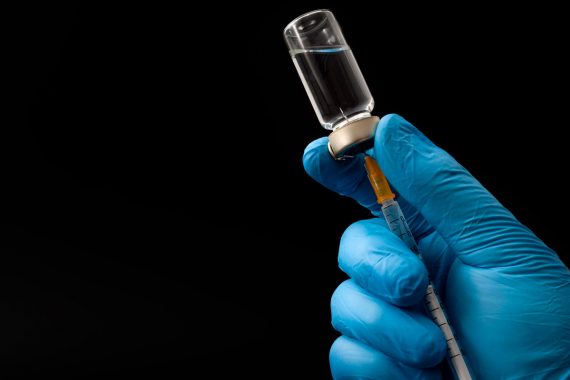The Covid-19 vaccination drive will require GPs to be both swift and ready to endure months of sustained effort, says Dr Peter English
Back in March last year, we often heard that managing the Covid-19 pandemic was ‘a marathon, not a sprint’. In reality, it’s been more like running a marathon every day. We are all Eddie Izzard now.
Part of that daily marathon is, and will be for the foreseeable future, vaccinating people against the disease. Only when we vaccinate all groups will the finish line come into view.
Currently we are in phase one, vaccinating those most at risk of a bad outcome from the virus, with the primary objective to reduce soaring hospital and ICU admissions and deaths. This is why the JCVI guidance changed to mandate a first dose of vaccine to as many people in these groups as possible.(1)
I agree with this change in policy. Trial data showed better-than-expected results from both the Pfizer and AstraZeneca vaccines, with efficacy of around 90%.
Two doses give an efficacy rate of 95%. The rate-limiting step now is vaccine availability. We can give 100 people (who might otherwise have been admitted) a single dose, potentially preventing 90 admissions over the next, critical 12 weeks, or we can give two doses to 50 people and prevent about 48 admissions. So, the best way to cut admissions is to give a single dose to as many at-risk people as is possible.
But vaccinating the most vulnerable is far from mission accomplished.
First, we don’t yet know vaccination will bring sterilising immunity, which prevents people from both catching the disease and passing it on. Levels of transmission can’t be observed in a phase III trial; this requires the much larger numbers from post-administration surveillance. That said, the T-cell and other responses seen from available Covid vaccines all strongly indicate that they will provide sterilising immunity – at least after a booster dose. Post-implementation surveillance will soon tell us more about this. (2)
Second, although most severe cases are of course in older and vulnerable people, a substantial number do occur in younger people without significant comorbidities. Vaccinating only the vulnerable won’t prevent such cases – for that, we’ll need to inoculate a much larger proportion of the population.
Third, and maybe most important, vaccinating all groups is the only way to ensure herd immunity, and thus prevent Covid-19 from becoming endemic. Herd immunity comes when each infected person, on average, infects less than one other person. Take a highly infectious disease like measles; if, say, R0 is about 18, you need >17 of every 18 people to be immune to ensure each case infects less than one person. With vaccination, the vaccine failure rate must be considered.
In the case of Covid, R0 was calculated earlier at approximately 3; in comparison, flu is about 2.(3) So for those infections, you’d need >2/3, and >1/2 of the population to be immune to achieve herd immunity.
But of course, it’s more complicated than that. The new B117 variant of SARS-CoV-2 is said to be about 70% more infectious, putting the R0 at just over 5. So you’d need >80% of the population to be immune to it. But we also need to take into account the k value – the proportion of infections caused by particular individuals. There is much more variability in the number of people each patient infects in Covid-19 than in flu: the most infectious 10% cause approximately 80% of Covid-19 transmissions.(4)
People who have a lot of contact with others and have mild or asymptomatic disease – and therefore do not refrain from interactions – are likely to be responsible for the vast majority of infections (remember, more than half of all Covid-19 transmission is from asymptomatic individuals).
In other words, to attain herd immunity, we will need to vaccinate healthy, younger people. Maybe not all of them but, depending on the actual future R0 value and vaccine efficacy, perhaps about 90% of them. Or they will have to gain their immunity through natural infection – and it’s not clear how long such immunity will last (which is also true for vaccine-generated immunity).
Otherwise the disease will continue to circulate, we will continue to see cases in people who are not immune, and younger, healthy people will continue to die at about the same rates as at present.
And so we must continue to be like Eddie Izzard, running daily marathons to reach as many people as quickly as possible in the months to come.
Dr Peter English is a former GP who sits on the executive committee of the BMA Public Health Committee. He is writing in a personal capacity
References
1 Joint Committee on Vaccination and Immunisation: advice on priority groups for COVID-19 vaccination, 30 December 2020. tinyurl.com/JCVI-covid-priorities
2 Public Health England. COVID-19 vaccine surveillance strategy: PHE, January 2021. tinyurl.com/PHE-covid-vax-surveillance
3 Petersen E, et al. Comparing SARS-CoV-2 with SARS-CoV and influenza pandemics. Lancet Infect Dis 2020;20(9):e238-e244 tinyurl.com/Petersen-compare
4 Nielsen BF and Sneppen K. COVID-19 superspreading suggests mitigation by social network modulation. medRxiv preprint, October 2020. tinyurl.com/covid-superspread
Related Articles
READERS' COMMENTS [2]
Please note, only GPs are permitted to add comments to articles

















Genuine question: how many people under 50 have died from covid? I understand that the virus is hugely more likely to severely affect the older generation- see kings fund: “Age: while some young and middle-aged adults can develop serious complications or die from Covid-19, the risks rise sharply with age because immune systems tend to deteriorate with age and because older people are more likely to have chronic conditions. For example, the mortality rate from Covid-19 in England and Wales at age 80–84 is about eight times greater than at age 60–64.”
My question is why whether we can feasibly expect to vaccinate 90% of the adult population before lifting these extremely damaging social interventions for the sake of the health (and wealth) of the nation? If the numbers who die under 50 are small might we not just need to accept the virus IS endemic and do our best to manage with annual vaccinations? We are not going to wipe out covid worldwide and surely we can not keep our borders closed forever. Too non-specific to identify every new case, and as you say there is significant asymptomatic spread…
I applaud and admire great scientific achievement and effort. But, repeated marathons cause blisters and trainers wear thin. And, no vaccine will change the brain, behaviour and ego. If anything, that will deteriorate into complacency. And that is where the UK problems lie. I have predicted 200,000 deaths by end 2022. That is my optimistic prediction, because there is no suppressive eradication strategy in Europe, just tolerance and casual privilege.